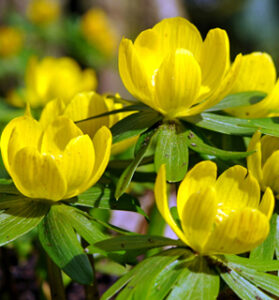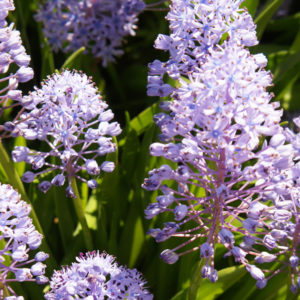Description
 Eranthis hyemalis
Eranthis hyemalis
CILICICA GROUP
Eranthis Cilicica hyemalis, also known as The Winter Aconite, has been a part of British gardens for so long, and it is so prevalent in Britain that most Brits believe the plant to be native to the British Isles. However, Eranthis Cilicica hyemalis is actually native to much of western Europe including France and Italy where it grows in deciduous forests and stony areas. The first written mention of the plant was in 1578. The name, Eranthis, comes from the Greek, er, meaning spring and anthos meaning flower.
Eranthis Cilicica hyemalis is an important pollinator plant because it blooms so early. During many springs it blooms earlier than the snowdrop with which it is often paired because the two blooming seasons overlap. The blooms of the cilicica group are very similar to those of the ordinary winter aconite, but they are a bit larger and the leaves are more finely cut. They flower slightly later than E. hyemalis they need full sun. Eranthis Cilicica is deer and rodent resistant, and is a good forcer. It also naturalizes very well.
Eranthis are not bulbs they are tuberous roots. This plant does best when planted under deciduous trees where it can be bathed in the sunlight while it is growing and blooming and then protected from the harsh summer sun. For best effect the roots should be planted in cluster of at least 10 roots.
Planting Bulbs in the Fall for Glorious Spring Color
Bulbs are some of the easiest plants to grow. Fundamentally the process requires four steps.
1. Dig a hole.
2. Dust the hole with bonemeal.
3. Place the bulb in the hole.
4. Fill the hole with soil.
There are, however, some additional refinements which help produce even more lavish results and enhance protection from critters.
First, bulbs can and should be planted deeper than the instructions you receive on the package labels. An easy way to remember how deep to plant the bulb is to think of a quarter. If the bulb you are planting has the same diameter as a quarter or less, plant the bulb 4 inches deep. If the bulb is broader than a quarter, plant it 6-10 inches deep. Large bulbs like some alliums, camassias, standard tulips and fritillaries can easily be planted 10 inches deep. As the soil compacts days, weeks and months after planting, it produces a thinner layer of soil on top of the bulb. Planting bulbs deep helps with critter control. Moles, voles, chipmunks and squirrels are lazy little creatures, and they don’t like doing a lot of digging to reach their food.
Second, bonemeal is a must. It is an excellent source of calcium and phosphorus which help the bulbs to form a strong root system and healthy stems. For large bulbs (those bigger than a quarter), use ¼ cup per bulb. For small bulbs, dust the entire surface or hole where the bulbs will reside.
Third, small bulbs should be planted in clusters of 10 or more – 1 inch apart. Large bulbs, like allium, can stand along, but create a much more pleasing presence in the garden when planted is clusters of 3-5. They should be separated by no more than 4-6 inches.
Fourth, bulbs usually multiply fairly quickly and once crowded will not produce blossoms. Plan to divide your bulbs in mid-summer to fall when the top growth has dried out.
These simple, easy, quick tasks are all that is required to produce a lovely bulb display year after year.
Planting Bulbs in Containers
If you live in Hardiness Zones 5 and higher all you need to do is mix some soil. . Check out the soil mix described in detail in our Harvesting History YouTube video. Do not use prepared soil mixes.
The Best Soil Mix for Containers
Always plant bulbs more densely in containers than in the ground. Pots as small as 6-inches in diameter can have a showy presence on a deck, porch or patio. You can use much larger pots and plant several kinds of bulbs.
Fill the pot half full, dust the soil surface with bonemeal, arrange the bulbs on top of the bone meal and fill the pot with the rest of the soil. Dust the surface of the soil with more bonemeal. Water thoroughly, but do not let the pot stand in a saucer of water.
If you live in Hardiness Zones 1-4, you must protect the pots by bringing them into an unheated garage or surrounding them with bales of straw. If you do not do this, the bulbs usually freeze and turn to mush.









